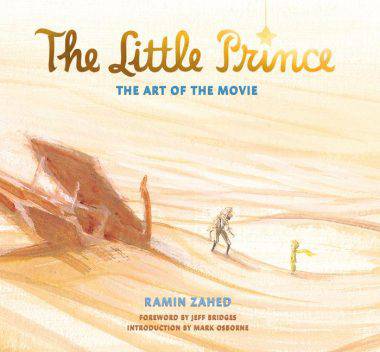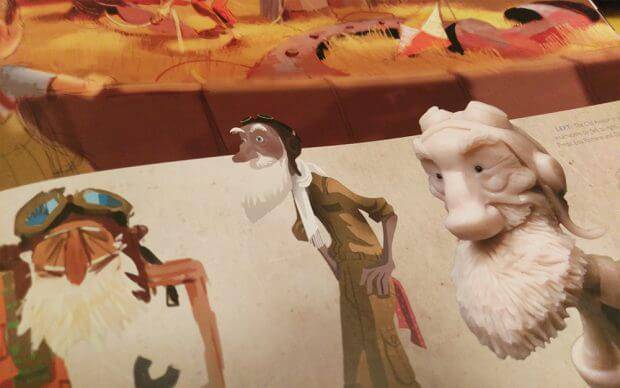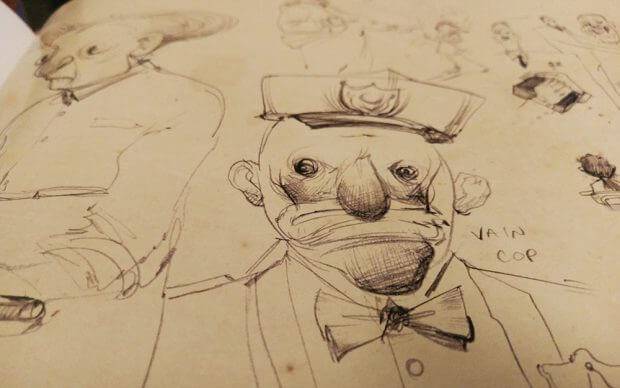‘The Little Prince: The Art of the Movie’ – book review
 A few months ago we in the UK were treated to the Netflix release of the animated adaption of The Little Prince. Following its rather uncertain distribution earlier in the year, it was with great joy that we received this heart warming and beloved tale via the popular subscription service.
A few months ago we in the UK were treated to the Netflix release of the animated adaption of The Little Prince. Following its rather uncertain distribution earlier in the year, it was with great joy that we received this heart warming and beloved tale via the popular subscription service.
The film takes on one of the most well-known and loved children’s books, breathing new life whilst keeping intact the lessons and wonder of the original illustrated tale, realised through a daring combination of CGI and stop-motion to fantastic effect, bringing together teams of artists undoubtedly at the height of their craft.
The accompanying book The Little Prince: The Art of the Movie, penned by Ramin Zahed, does a wonderful job at looking at the ins and out of all areas of production as well as tackling the integral question of how to go about adapting such a well-known story whilst making it cinematically engaging and indeed long enough for a feature-length animated adventure.
Beginning with forwards from both director Mark Osborne and voice performer Jeff Bridges – in which they discuss the approach to visualising the original tale along with Osborne’s unique way of pitching the film in which he used a hand crafted ‘magic suitcase’ – throughout the book the worlds, characters and cinematic devices are examined, discussed and accompanied by high quality images that give us a strong insight into all aspects of this massive film’s production.
 As with the film, the book is laid out in a way that explores three major worlds. The first world in which the Little Girl lives with her mother, is full of rules, responsibility and straight lines – that is until she meets the old Aviator, – whose house and stories blur the line between hers and that of the Little Prince, rendered in stylistic CGI with a flavour of both Americana and Parisian.
As with the film, the book is laid out in a way that explores three major worlds. The first world in which the Little Girl lives with her mother, is full of rules, responsibility and straight lines – that is until she meets the old Aviator, – whose house and stories blur the line between hers and that of the Little Prince, rendered in stylistic CGI with a flavour of both Americana and Parisian.
We move into the paper, stop-frame world that defines the more literal and faithful translation of the story by Antoine de Saint-Exupéry, which is intercut between the scenes from the Little Girl’s world, which acts as a framing device for the original tale. This wonderful, texture-rich universe of planets, puppets and practical effects was crafted through the joint efforts of Jamie Caliri, Alexander Juhasz, Corinne Merrell and Anthony Scott along with their tireless crew who fabricated a plethora of sets, replaceable faces and hands, all brought together with an almost magical understanding of lighting and visual storytelling (our full interview with the stop-motion crew can be found here). The book revels in a clear but full layout of behind-the-scenes photos, interviews and descriptions of many of the painstaking techniques used to create the stop-motion sequence within the film that, for me, made the book worth it just by itself.
The final world we see is that of the third act of the film, which amalgamates the two previous worlds bringing the Little Girl and Prince together, dealing more forthrightly with the themes of the original book about love, death and growing up. The use of secondary character from the previous two worlds is discussed whilst drawing upon the use of design and the thought process behind this final section of the film.
This being the Art Of book, there are also several sections devoted to individual concept artists, colour designers and character artists who were highly influential during the building of individual characters as well as the film as a whole. People such as Peter de Sève (A Bug’s Life, Finding Nemo), Lou Romano (The Incredibles, Up), Céline Desrumaux (Harry Potter and the Deathly Hallows: Part 1) all of whom brought a unique aspect to the film along with their years of experience, making for a crack team of designers and makers to achieve a ground breaking new film.
 Each character is discussed in detail in terms of personal response, takes on the look, ideas and thoughts on their personalities, with certain characters popping up twice such as the Aviator, the Fox and the Little Prince depending on what stage or universe they inhabit. With a full range of designers and artists working on every aspect of these characters’ individual traits, there is a multitude of different art works and ideas at play that could have taken the film in thousands of different directions in both look and tone. The book truly offers a unique insight into the process and hard work that goes into adaptation as well as creating something new.
Each character is discussed in detail in terms of personal response, takes on the look, ideas and thoughts on their personalities, with certain characters popping up twice such as the Aviator, the Fox and the Little Prince depending on what stage or universe they inhabit. With a full range of designers and artists working on every aspect of these characters’ individual traits, there is a multitude of different art works and ideas at play that could have taken the film in thousands of different directions in both look and tone. The book truly offers a unique insight into the process and hard work that goes into adaptation as well as creating something new.
There are also mentions of individual elements of the production, such as the approaches to cloth and hair within the CG realm of the film, as well as the reasoning behind the exclusion of certain adult characters from the original book, as well as discussion of some of the complexities (such as the star releasing scene) and the minutiae of production.
The film is fantastic in terms of technical achievement, and although some people’s personal relationship with its source material may colour their feelings toward it, there is no denying that it was made by a group of individuals whose connection to the project was sincere and personal. This book is a true account of both the art, the thought and the personal feelings that Osborne and the crew put into the film along with their sweat, tears and heart.
The Little Prince: The Art of the Movie is available now through Titan Books

